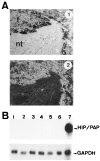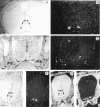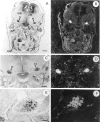HIP/PAP gene, encoding a C-type lectin overexpressed in primary liver cancer, is expressed in nervous system as well as in intestine and pancreas of the postimplantation mouse embryo
- PMID: 10329612
- PMCID: PMC1866603
- DOI: 10.1016/S0002-9440(10)65413-2
HIP/PAP gene, encoding a C-type lectin overexpressed in primary liver cancer, is expressed in nervous system as well as in intestine and pancreas of the postimplantation mouse embryo
Abstract
We originally isolated the HIP/PAP gene in a differential screen of a human hepatocellular carcinoma cDNA library. This gene is expressed at high levels in 25% of primary liver cancers but not in nontumorous liver. HIP/PAP belongs to the family of C-type lectins and acts as an adhesion molecule for hepatocytes. In normal adult human tissues, HIP/PAP expression is found in pancreas (exocrine and endocrine cells) and small intestine (Paneth and neuroendocrine cells). In order to gain insight into the possible role of HIP/PAP in vivo, we have investigated the pattern of HIP/PAP expression in the developing postimplantation mouse embryo by in situ hybridization. Detailed analysis of developing mouse embryos revealed that HIP/PAP gene exhibits a restricted expression pattern during development. Thus, HIP/PAP transcripts are first observed within the nervous system from day 14.5 onwards in trigeminal ganglia, dorsal root ganglia, and spinal cord where it appears to be an early specific marker of a subpopulation of motor neurons. At laster stages, HIP/PAP transcripts were detected in intestine and pancreas at day 16.5 but not in embryonic liver. This highly restricted expression pattern suggests that HIP/PAP might participate in neuronal as well as intestinal and pancreatic cell development.
Figures






References
-
- Drickamer K, Taykor ME: Biology of animal lectins. Annu Rev Cell Biol 1993, 9:237-264 - PubMed
-
- Ochieng J, Warfield P: Galectin-3 binding potentials of mouse tumor EHS and human placental laminins. Biochem Biophys Res Commun 1995, 217:402-406 - PubMed
-
- Drickamer K: Two distinct classes of carbohydrate-recognition domain in animal lectins. J Biol Chem 1988, 263:9557-9560 - PubMed
-
- Lasserre C, Christa L, Simon M-T, Vernier P, Brechot C: A novel gene (HIP) activated in human primary liver cancer. Cancer Res 1992, 52:5089-5095 - PubMed
-
- Christa I, Felin M, Morali O, Simon M-T, Lasserre C, Brechot C, Seve A-P: The human HIP gene, overexpressed in primary liver cancer encodes a C-type carbohydrate binding protein with lactose binding activity. FEBS Lett 1994, 337:114-118 - PubMed
MeSH terms
Substances
LinkOut - more resources
Full Text Sources
Medical
Molecular Biology Databases
Research Materials

